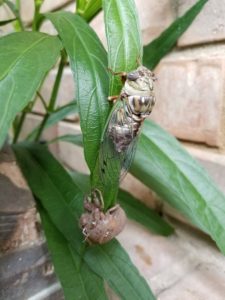Have you been hearing loud noises in trees when you go outside lately? Male cicadas are well known for their “song”. They rest on trees and produce a whining sound that is attractive to females (cicada females, that is…). The sound is produced by two vibrating membranes on the side of the cicada abdomen. Fortunately, for those who do not enjoy the “music”, female cicadas do not “sing”.
Cicadas are fairly large insects with some growing over 1 1/2 inches. Color can vary depending upon the species, but many are browns and greens. All cicadas have bulging eyes and, on adults, wings that are held roof-like over the body. The wings are semi-transparent with thick veins.
Cicadas have a 2-5 year life cycle, the majority of which is spent underground. After mating, females insert egg clusters into branches of trees using their saw-like ovipositor (egg laying structure). Eggs hatch after about 6 weeks and small nymphs drop to the ground where they burrow into the soil. Nymphs feed on the sap of tree roots with their piercing-sucking mouthparts. After nymphs have fully developed, they emerge from the ground at night and climb up nearby objects like tree trunks, plants, fences, etc. Adult cicadas emerge from the last nymphal stage, leaving behind the exuviae (cast skin/ exoskeleton). Adults can live 5-6 weeks.